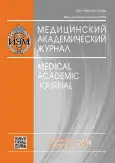ANTIAPOPTOSIS ACTIVITY OF PLANT POLYPRENYLPHOSPHATE AGAINST MACROPHAGE TARGET CELLS INFECTED WITH THE MURINE ENCEPHALOMYELITIS VIRUS
- Authors: Kozhevnikova TN1, Sanin AV1, Ozherelkov SV2
-
Affiliations:
- The Gamaleya Scientific Research Institute of Epidemiology and Microbiology, Moscow
- M.P.Chumakov Federal Scientific Center for Research and Development of Immunobiological Preparations, Moscow region
- Issue: Vol 19, No 1S (2019)
- Pages: 207-209
- Section: Articles
- Published: 15.12.2019
- URL: https://journals.eco-vector.com/MAJ/article/view/19400
- ID: 19400
Cite item
Abstract
Antiapoptosis activity of plant polyprenylphosphate against macrophage target cells infected with the murine encephalomyelitis virus. Infection caused by the Theiler’s murine encephalomyelitis virus (TMEV) is regarded as an experimental model of multiple sclerosis, since both of these diseases are characterized by similar pathology of the central nervous system tissues and involvement of the immune system in the development of the demielinization. The aim of the work was to study the effect of plant-derived polyprenylphosphate (PP) on the apoptosis of infected target cells. We showed that PP reduced apoptosis of macrophage target cells infected with TMEV. It is known that in the protocol of multiple sclerosis treatment some medicines possessing immunomodulatory, antiviral, anti-inflammatory and antioxidant activity are used. Since PPs of plant origin also have all these activities, the prospects of their use as therapeutic agents are discussed.
Full Text
About the authors
T N Kozhevnikova
The Gamaleya Scientific Research Institute of Epidemiology and Microbiology, Moscow
A V Sanin
The Gamaleya Scientific Research Institute of Epidemiology and Microbiology, Moscow
S V Ozherelkov
M.P.Chumakov Federal Scientific Center for Research and Development of Immunobiological Preparations, Moscow region
References
- Ганшина И.В., Судьина Г.Ф., Санина В.Ю., и др. Фосфорилированные полипренолы - новый класс соединений с противовоспалительной и бронхолитической активностью // Инфекция и иммунитет. - 2011. - Т. 1. - № 4. - С. 355-360.
- Кожевникова Т.Н., Ожерелков С.В., Изместьева А.В., и др. Влияние препаратов Гамапрен и Фоспренил, созданных на основе полипренолов растительного происхождения, на продукцию некоторых регуляторных цитокинов в норме и при экспериментальном клещевом энцефалите у мышей // Российский иммунологический журнал. - 2008. - Т. 11. - № 2-3. - С. 250.
- Ожерелков С.В., Белоусова Р.В., Данилов Л.Л., и др. Препарат фоспренил подавляет размножение вирусов диареи и инфекционного ринотрахеита крупного рогатого скота в чувствительных культурах клеток // Вопр. вирусол. - 2001. - Т. 5. - С. 43-45.
- Ожерелков С.В., Калинина Е.С, Кожевникова Т.Н., и др. Экспериментальное исследование феномена антителозависимого усиления инфекционности вируса клещевого энцефалита in vitro // ЖМЭИ. - 2008. - № 6. - С. 39-43.
- Санин А.В., Суслов А.П., Третьяков О.Ю., и др. Разнонаправленное влияние MIF и полипренилфосфата на течение экспериментальной флавивирусной инфекции у мышей // Ж. микробиол. - 2011. - № 5. - С. 56-61.
- Санин А.В., Наровлянский А.Н., Пронин А.В., и др. Изучение антиоксидантных свойств Фоспренила в различных биологических тест-системах // РВЖ МДЖ. - 2017. - № 10. - С. 28-31.
- Санин А.В., Наровлянский А.Н., Пронин А.В., и др. Эффективность фоспренила при профилактике экспериментального стресса in vitro // Ветеринария. - 2016. - № 10. - С. 11-13.
- Roos RP. Infection of macrophages by Theiler’s Virus. J.of Virology. 2002;76(24):12823-12833.
- Luessi F, Siffrin V, Zipp F. Neurodegeneration in multiple sclerosis: novel treatment strategies. Expert Rev Neurother. 2012;12(9):1061-76.
Supplementary files







